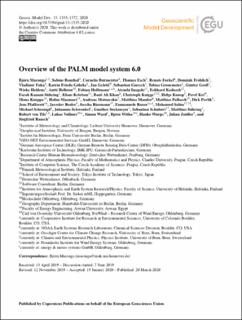| dc.contributor.author | Maronga, Bjørn | |
| dc.contributor.author | Banzhaf, Sabine | |
| dc.contributor.author | Burmeister, Cornelia | |
| dc.contributor.author | Esch, Thomas | |
| dc.contributor.author | Forkel, Renate | |
| dc.contributor.author | Fröhlich, Dominik | |
| dc.contributor.author | Fuka, Vladimir | |
| dc.contributor.author | Gehrke, Katrin Frieda | |
| dc.contributor.author | Geletič, Jan | |
| dc.contributor.author | Giersch, Sebastian | |
| dc.contributor.author | Gronemeier, Tobias | |
| dc.contributor.author | Groß, Günter | |
| dc.contributor.author | Heldens, Wieke | |
| dc.contributor.author | Hellsten, Antti | |
| dc.contributor.author | Hoffmann, Fabian | |
| dc.contributor.author | Inagaki, Atsushi | |
| dc.contributor.author | Kadasch, Eckhard | |
| dc.contributor.author | Kanani-Sühring, Farah | |
| dc.contributor.author | Ketelsen, Klaus | |
| dc.contributor.author | Ali Khan, Basit | |
| dc.contributor.author | Knigge, Christoph | |
| dc.contributor.author | Knoop, Helge | |
| dc.contributor.author | Krč, Pavel | |
| dc.contributor.author | Kurppa, Mona | |
| dc.contributor.author | Maamari, Halim | |
| dc.contributor.author | Matzarakis, Andreas | |
| dc.contributor.author | Mauder, Matthias | |
| dc.contributor.author | Pallasch, Matthias | |
| dc.contributor.author | Pavlik, Dirk | |
| dc.contributor.author | Pfafferott, Jens | |
| dc.contributor.author | Resler, Jaroslav | |
| dc.contributor.author | Rissmann, Sascha | |
| dc.contributor.author | Russo, Emmanuele | |
| dc.contributor.author | Salim, Mohamed | |
| dc.contributor.author | Schrempf, Michael | |
| dc.contributor.author | Schwenkel, Johannes | |
| dc.contributor.author | Seckmeyer, Gunther | |
| dc.contributor.author | Schubert, Sebastian | |
| dc.contributor.author | Sühring, Matthias | |
| dc.contributor.author | von Tils, Robert | |
| dc.contributor.author | Vollmer, Lukas | |
| dc.contributor.author | Ward, Simon | |
| dc.contributor.author | Witha, Björn | |
| dc.contributor.author | Wurps, Hauke | |
| dc.contributor.author | Zeidler, Julian | |
| dc.contributor.author | Raasch, Siegfried | |
| dc.date.accessioned | 2021-07-16T09:13:25Z | |
| dc.date.available | 2021-07-16T09:13:25Z | |
| dc.date.created | 2020-04-20T12:28:56Z | |
| dc.date.issued | 2020 | |
| dc.identifier.issn | 1991-959X | |
| dc.identifier.uri | https://hdl.handle.net/11250/2764628 | |
| dc.description.abstract | In this paper, we describe the PALM model system 6.0. PALM (formerly an abbreviation for Parallelized Large-eddy Simulation Model and now an independent name) is a Fortran-based code and has been applied for studying a variety of atmospheric and oceanic boundary layers for about 20 years. The model is optimized for use on massively parallel computer architectures. This is a follow-up paper to the PALM 4.0 model description in Maronga et al. (2015). During the last years, PALM has been significantly improved and now offers a variety of new components. In particular, much effort was made to enhance the model with components needed for applications in urban environments, like fully interactive land surface and radiation schemes, chemistry, and an indoor model. This paper serves as an overview paper of the PALM 6.0 model system and we describe its current model core. The individual components for urban applications, case studies, validation runs, and issues with suitable input data are presented and discussed in a series of companion papers in this special issue. | en_US |
| dc.language.iso | eng | en_US |
| dc.publisher | Copernicus | en_US |
| dc.rights | Navngivelse 4.0 Internasjonal | * |
| dc.rights.uri | http://creativecommons.org/licenses/by/4.0/deed.no | * |
| dc.title | Overview of the PALM model system 6.0 | en_US |
| dc.type | Journal article | en_US |
| dc.type | Peer reviewed | en_US |
| dc.description.version | publishedVersion | en_US |
| dc.rights.holder | Copyright the authors 2020 | en_US |
| cristin.ispublished | true | |
| cristin.fulltext | original | |
| cristin.qualitycode | 2 | |
| dc.identifier.doi | 10.5194/gmd-13-1335-2020 | |
| dc.identifier.cristin | 1807122 | |
| dc.source.journal | Geoscientific Model Development | en_US |
| dc.source.pagenumber | 1335-1372 | en_US |
| dc.identifier.citation | Geoscientific Model Development. 2020, 13 (3), 1335-1372. | en_US |
| dc.source.volume | 13 | en_US |
| dc.source.issue | 3 | en_US |

